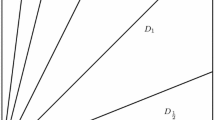Abstract
Semiorders may form the simplest class of ordered sets with a not necessarily transitive indifference relation. Their generalization has given birth to many other classes of ordered sets, each of them characterized by an interval representation, by the properties of its relations or by forbidden configurations. In this paper, we are interested in preference structures having an interval representation. For this purpose, we propose a general framework which makes use of n-point intervals and allows a systematic analysis of such structures. The case of 3-point intervals shows us that our framework generalizes the classification of Fishburn by defining new structures. Especially we define three classes of ordered sets having a non-transitive indifference relation. A simple generalization of these structures provides three ordered sets that we call “d-weak orders”, “d-interval orders” and “triangle orders”. We prove that these structures have an interval representation. We also establish some links between the relational and the forbidden mode by generalizing the definition of a Ferrers relation.
Similar content being viewed by others
References
Armstrong, W. E. (1939). The determinateness of the utility function. The Economic Journal, 49, 453–467.
Baker, K. A., Fishburn, P. C., & Roberts, F. S. (1972). Partial orders of dimension 2. Networks, 2, 11–28.
Bogart, K. P., & Trenk, A. N. (1994). Bipartite tolerance orders. Discrete Mathematics, 132, 11–22.
Chipman, J. S. (1971). Consumption theory without transitive indifference. In J. S. Chipman, L. Hurwicz, M. K. Richter, & H. F. Sonnenschein (Eds.), Preferences, utility and demand (pp. 224–253). Harcourt Brace Jovanovich.
Dushnik, B., & Miller, E. W. (1941). Partially ordered sets. American Journal of Mathematics, 63, 600–610.
Fechner, G. T. (1860). Elemente der Psychophysik. Breitkof und Hartel.
Fishburn, P. C. (1970a). Intransitive indifference with unequal indifference intervals. Journal of Mathematical Psychology, 7, 144–149.
Fishburn, P. C. (1970b). Utility theory for decision making. New York: Wiley.
Fishburn, P. C. (1985). Interval orders and interval graphs. New York: Wiley.
Fishburn, P. C. (1997). Generalisations of semiorders: a review note. Journal of Mathematical Psychology, 41, 357–366.
Fishburn, P. C., & Monjardet, B. (1992). Wiener on the theory of measurement (1914, 1915, 1921). Journal of Mathematical Psychology, 36, 165–184.
Georgescu-Roegen, N. (1936). The pure theory of consumer’s behavior. Quarterly Journal of Economics, 50, 545–593.
Halphen, E. (1955). La notion de vraisemblance (Technical Report 4(1)). Publication de l’I.S.U. P.
Luce, R. D. (1956). Semiorders and a theory of utility discrimination. Econometrica, 24, 178–191.
Monjardet, B. (1978). Axiomatiques et propriétés des quasi ordres. Mathématiques et Sciences Humaines, 63, 51–82.
Öztürk, M. (2005). Mathematical and logical structures for interval comparison. PhD thesis, Université Paris Dauphine.
Öztürk, M., & Tsoukiàs, A. (2006). Preference representation with 3-points intervals. In Proceedings of the ECAI-06 (pp. 417–421). Riva del Garda, Italy. August 28–September 1 2006.
Pirlot, M., & Vincke, Ph. (1997). Semi Orders. Dordrecht: Kluwer Academic.
Poincaré, H. (1905). La valeur de la science. Paris: Flammarion.
Rabinovitch, I. (1978). The dimension of semiorders. Journal of Combinatorial Theory A, 25, 50–61.
Riguet, J. (1950). Sur les ensembles réguliers de rélations binaires, les relations de Ferrers. Comptes Rendus de l’Académie des Sciences, 231, 936–937.
Scott, D., & Suppes, P. (1958). Foundational aspects of theories of measurement. Journal of Symbolic Logic, 23, 113–128.
Trenk, A. N. (1998). On k-weak orders: recognition and a tolerance result. Discrete Mathematics, 181, 223–237.
Trotter, W. T. (1992). Combinatorics and partially ordered sets. Baltimore: John Hopkins University Press.
Author information
Authors and Affiliations
Corresponding author
Rights and permissions
About this article
Cite this article
Öztürk, M. Ordered sets with interval representation and (m,n)-Ferrers relation. Ann Oper Res 163, 177–196 (2008). https://doi.org/10.1007/s10479-008-0334-1
Received:
Accepted:
Published:
Issue Date:
DOI: https://doi.org/10.1007/s10479-008-0334-1




